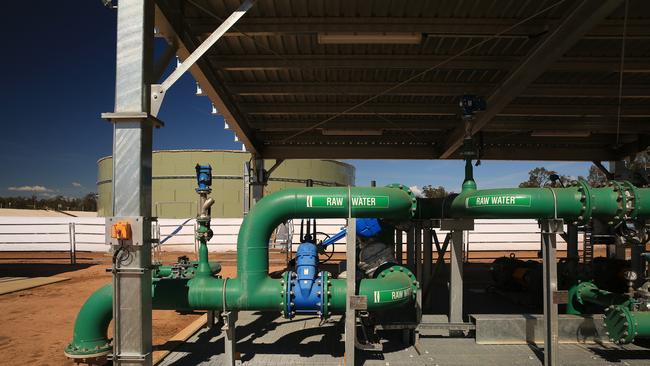NSW government shifting on Narrabri coal seam gas, Santos says
The prospect of gas shortages may be shifting the NSW government’s stance on CSG at Narrabri.

Energy producer Santos says its controversial Narrabri coal seam gas project is gaining traction with NSW Premier Gladys Berejiklian amid a prolonged energy squeeze in the state.
With NSW importing 95 per cent of its gas needs, momentum appears to be building for the government to ease delays which have hobbled efforts to bring new supplies online, including the $3.6 billion Narrabri project in the state’s northwest.
Santos chief executive Kevin Gallagher said he believed the Narrabri project is gaining traction with Ms Berejiklian as part of a gradual shift in sentiment within the governing Liberal party.
“We see the headwinds are slowly shifting,” he said. “They’re not quite tailwinds yet, but they’re on their way to becoming tailwinds,” Mr Gallagher told the Credit Suisse Australian Energy conference in Sydney on Wednesday.
Santos faces a test, however, to win approval for its proposal following strong environmental opposition from activist groups like Lock The Gate over the effect drilling may have on Great Artesian Basin water supplies and nearby farmland.
Responding to The Australian’s report of Mr Gallagher’s remarks, Lock the Gate said Santos had five years ago been given 12 months to fast-track the Narrabri project, but had failed to submit to proper environment assessment.
“From Santos’ comments at the Credit Suisse event, it sounds as if it has lobbied the premier and treasurer directly, but neither of those politicians have the power to make a decision about this gasfield,” Lock the Gate spokeswoman Georgina Woods said.
“In NSW, that’s done via an independent commission to avoid precisely this kind of inappropriate political interference.”
Santos was at the centre of the problems with gas supply and prices on the eastern seaboard, Ms Woods said. “Santos is the key architect of the gas price crisis in eastern Australia. It led the charge to build the export terminals at Gladstone in Queensland, linking us to the international market and driving up costs.
“Pulling up a small amount of gas at high risk and high cost from Narrabri will do nothing to reduce the price of gas for manufacturers.”
The NSW Department of Planning and Environment is reviewing the project before it proceeds to the state’s Independent Planning Commission, with Santos hopeful of receiving planning approval before the end of 2019.
NSW is expected to join Victoria and South Australia in suffering from gas shortages on peak demand days from 2023 and the government appears more willing to consider new supply sources to help plug the shortfall and potentially provide some price relief.
Narrabri could provide half NSW’s annual gas needs, while an LNG import terminal located at Port Kembla, backed by iron ore billionaire Andrew Forrest, could meet 70 per cent of the state’s gas demand.
“The NSW Government is exploring all practical measures to guarantee the state’s future gas supply,” Deputy Premier and Minister for Resources John Barilaro told The Australian last week.
“In NSW there is no doubt that we have to explore all opportunities for gas, and the proposed Narrabri gas project is one of those potential opportunities.”
NSW gas users last month threatened to pull $2bn of planned spending from the state as frustrations mount that delays approving Narrabri will cripple the viability of manufacturers’ investment pipeline.
Developer Santos issued a plea for the NSW government to outline its approval timeline after submitting its environmental impact statement in February 2017.
With AGL Energy’s giant Liddell coal plant due to shut in 2022, Energy Minister Matt Kean emphasised earlier this month the state needs to take a more pragmatic approach to its medium term power generation mix.
New supply sources to replace Liddell’s capacity could be fast-tracked to ensure the state is not left empty-handed while the government will also work to boost its native gas supplies, Mr Kean said.
NSW Treasurer Dominic Perrottet said the government was focused on ensuring a reliable electricity grid and lowering power prices which have been inflated in the last few years by high gas costs.
“The most important thing is to ensure we have a stable power supply and continue to work on driving power prices lower,” Mr Perrottet said. “We need to examine all the options to ensure power prices are driven lower and supply across the grid is stable.”


To join the conversation, please log in. Don't have an account? Register
Join the conversation, you are commenting as Logout